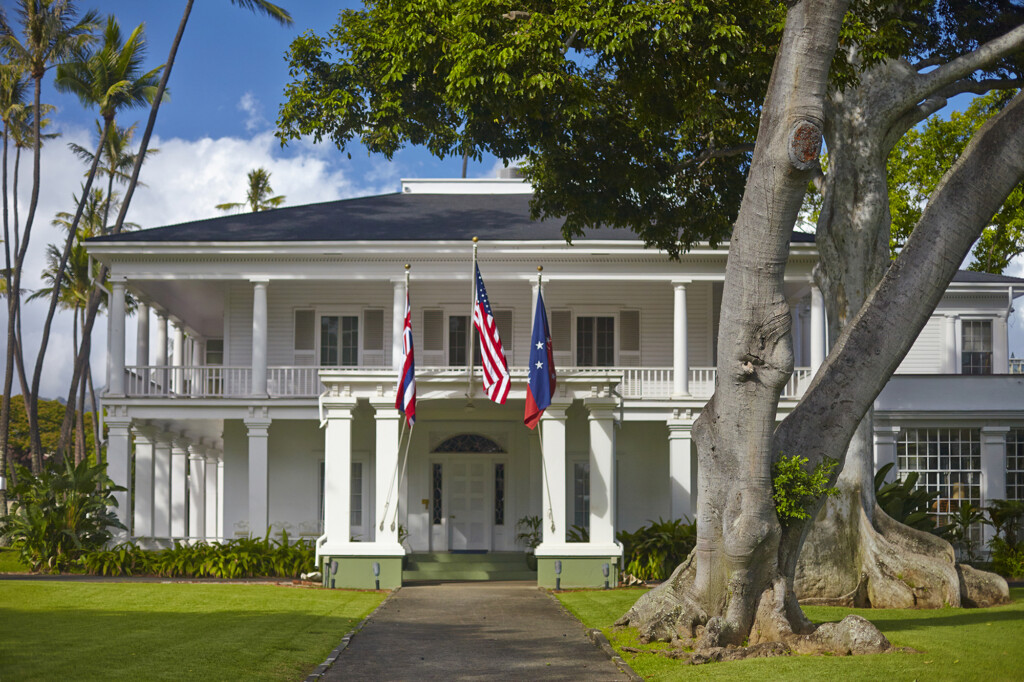
Washington Place. Photo Courtesy of Washington Place Foundation.
Washington Place is one of O‘ahu’s most treasured landmarks as the home of Hawai‘i’s last ruling monarch and subsequent state governors and their families. The treasured stories of this place are never to be forgotten. This year, Washington Place turns 175 years! Let us take a look back at its history.
The construction of Washington Place began in 1842 as the residence of Captain John Dominis, an American ship captain and merchant, and his wife Mary and their son John Owen. Unfortunately, the captain was lost at sea and was never able to live in the house upon its completion in 1847. In order to retain ownership of the home, his wife, Mary Dominis, chose to take in boarders, including Anthony Ten Eyck, the United States Commissioner, who suggested to Mrs. Dominis in 1848 that she name the house after America’s first president, George Washington. Permission was granted by King Kamehameha lll with the provision that the house keep the name “in all time coming.”1
The architecture of Washington Place is a distinctive combination of Greek revival elements and indigenous materials, including coral and rare woods. According to “175 Years at Washington Place,”2 a booklet researched and written by architect Katie Stephens and historian Don J. Hibbard for the Hawai‘i State Foundation on Culture and the Arts, Captain Dominis wrote to friends in Boston asking for their help with procuring items, such as door and window sashes, blinds, locks, glass and lumber, for the new house. When ordering the items, Dominis seems to have “specified the materials according to his own ideas for the building,” in some cases adding his own drawings to illustrate them. Washington Place is “a product of Captain Dominis’ concept, the Boston suppliers’ interpretation, and the execution of Honolulu’s builders,” including carpenter Isaac S. Hart who supervised the construction.

Queen Lili‘uokalani standing outside of Washington Place in 1893. Photo courtesy of Bishop Museum via Wikimedia Commons.
To this day, Washington Place is best known as the residence of the beloved Queen Lili‘uokalani. She first moved into the home in 1862 as Lydia Pākī, the bride of John Owen Dominis, son of John and Mary Dominis, and it remained her private residence for 55 years, until her death in 1917.
In her personal diary she described the home favorably:
“It is a large square white house, with pillars and portico on all sides, really a palatial dwelling as comfortable in its appointments as it is inviting in its aspect; its front is distant from the street far enough to avoid the dust and noise. Trees shade its walls from the heat of noonday; its ample gardens filled with the choicest flowers and shrubs; it is, in fact, just what it appears, a choice tropical retreat in the midst of the chief city of the Hawaiian Islands.”3
Following the queen’s death, Washington Place became the official residence of Hawai‘i’s territorial and statehood governors until 2002. From 2002 to the present, Washington Place serves as the executive mansion of the Governor of the State of Hawai‘i, functioning as a gathering place and educational resource. Special efforts have been made to restore the historic features of the building. Rooms on the second floor serve as gallery spaces that highlight the home’s historic significance.
Washington Place was listed to the National Register of Historic Places in 1973 and designated as a National Historic Landmark in 2007. We can take comfort in knowing that this place and all the stories associated with it are being preserved.
The 175th anniversary of Washington Place will be celebrated at the 2022 Preservation Honor Awards Ceremony and Reception on October 20, 2022. Click here for information about the event.
Citations:
1State of Hawaiʻi, Department of Accounting and General Services, “Discover the History of Washington Place,” Washington Place Hawai‘i website, https://washingtonplace.hawaii.gov/history.
2Katie Stephens and Don J. Hibbard, “175 Years at Washington Place,” State of Hawaiʻi Foundation on Culture and the Arts, page 3.
3David W. Forbes,”Hawai‘i’s Story by Hawai‘i’s Queen,” University of Hawai‘i Press, page 36.
Further resources:
- The 175 years of history at Washington Place was commemorated by the State of Hawaiʻi earlier this year with a variety of programming, including music and hula performances, new publications, and a host of visual presentations. See the list here: https://washingtonplace.hawaii.gov/news-and-events/in-the-news.
- Hawai‘i and National Register of Historic Places nomination form: https://historichawaii.org/2014/02/19/washington-place/

